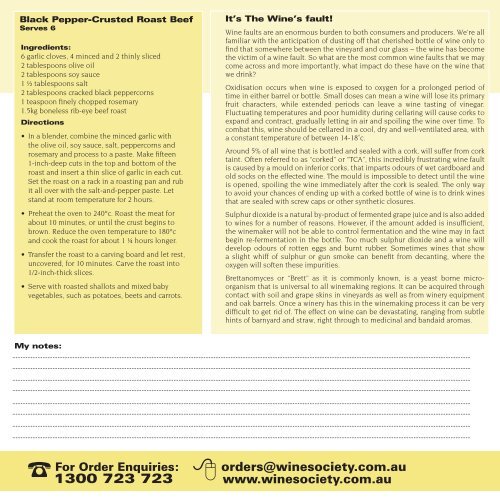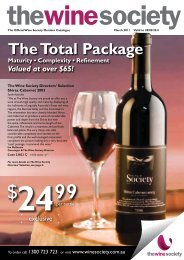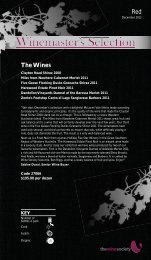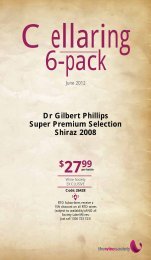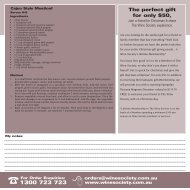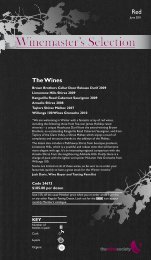Winemaster's Selection March 2008 - Red - The Wine Society
Winemaster's Selection March 2008 - Red - The Wine Society
Winemaster's Selection March 2008 - Red - The Wine Society
Create successful ePaper yourself
Turn your PDF publications into a flip-book with our unique Google optimized e-Paper software.
Black Pepper-Crusted Roast Beef<br />
Serves 6<br />
Ingredients:<br />
6 garlic cloves, 4 minced and 2 thinly sliced<br />
2 tablespoons olive oil<br />
2 tablespoons soy sauce<br />
1 ½ tablespoons salt<br />
2 tablespoons cracked black peppercorns<br />
1 teaspoon finely chopped rosemary<br />
1.5kg boneless rib-eye beef roast<br />
Directions<br />
• In a blender, combine the minced garlic with<br />
the olive oil, soy sauce, salt, peppercorns and<br />
rosemary and process to a paste. Make fifteen<br />
1-inch-deep cuts in the top and bottom of the<br />
roast and insert a thin slice of garlic in each cut.<br />
Set the roast on a rack in a roasting pan and rub<br />
it all over with the salt-and-pepper paste. Let<br />
stand at room temperature for 2 hours.<br />
• Preheat the oven to 240°c. Roast the meat for<br />
about 10 minutes, or until the crust begins to<br />
brown. <strong>Red</strong>uce the oven temperature to 180°c<br />
and cook the roast for about 1 ¼ hours longer.<br />
• Transfer the roast to a carving board and let rest,<br />
uncovered, for 10 minutes. Carve the roast into<br />
1/2-inch-thick slices.<br />
• Serve with roasted shallots and mixed baby<br />
vegetables, such as potatoes, beets and carrots.<br />
It’s <strong>The</strong> <strong>Wine</strong>’s fault!<br />
<strong>Wine</strong> faults are an enormous burden to both consumers and producers. We’re all<br />
familiar with the anticipation of dusting off that cherished bottle of wine only to<br />
find that somewhere between the vineyard and our glass – the wine has become<br />
the victim of a wine fault. So what are the most common wine faults that we may<br />
come across and more importantly, what impact do these have on the wine that<br />
we drink?<br />
Oxidisation occurs when wine is exposed to oxygen for a prolonged period of<br />
time in either barrel or bottle. Small doses can mean a wine will lose its primary<br />
fruit characters, while extended periods can leave a wine tasting of vinegar.<br />
Fluctuating temperatures and poor humidity during cellaring will cause corks to<br />
expand and contract, gradually letting in air and spoiling the wine over time. To<br />
combat this, wine should be cellared in a cool, dry and well-ventilated area, with<br />
a constant temperature of between 14-18˚c.<br />
Around 5% of all wine that is bottled and sealed with a cork, will suffer from cork<br />
taint. Often referred to as “corked” or “TCA”, this incredibly frustrating wine fault<br />
is caused by a mould on inferior corks, that imparts odours of wet cardboard and<br />
old socks on the effected wine. <strong>The</strong> mould is impossible to detect until the wine<br />
is opened, spoiling the wine immediately after the cork is sealed. <strong>The</strong> only way<br />
to avoid your chances of ending up with a corked bottle of wine is to drink wines<br />
that are sealed with screw caps or other synthetic closures.<br />
Sulphur dioxide is a natural by-product of fermented grape juice and is also added<br />
to wines for a number of reasons. However, if the amount added is insufficient,<br />
the winemaker will not be able to control fermentation and the wine may in fact<br />
begin re-fermentation in the bottle. Too much sulphur dioxide and a wine will<br />
develop odours of rotten eggs and burnt rubber. Sometimes wines that show<br />
a slight whiff of sulphur or gun smoke can benefit from decanting, where the<br />
oxygen will soften these impurities.<br />
Brettanomyces or “Brett” as it is commonly known, is a yeast borne microorganism<br />
that is universal to all winemaking regions. It can be acquired through<br />
contact with soil and grape skins in vineyards as well as from winery equipment<br />
and oak barrels. Once a winery has this in the winemaking process it can be very<br />
difficult to get rid of. <strong>The</strong> effect on wine can be devastating, ranging from subtle<br />
hints of barnyard and straw, right through to medicinal and bandaid aromas.<br />
My notes:<br />
For Order Enquiries:<br />
1300 723 723<br />
orders@winesociety.com.au<br />
www.winesociety.com.au<br />
marchwinemastersreds.indd 4<br />
7/02/<strong>2008</strong> 4:15:28 PM


